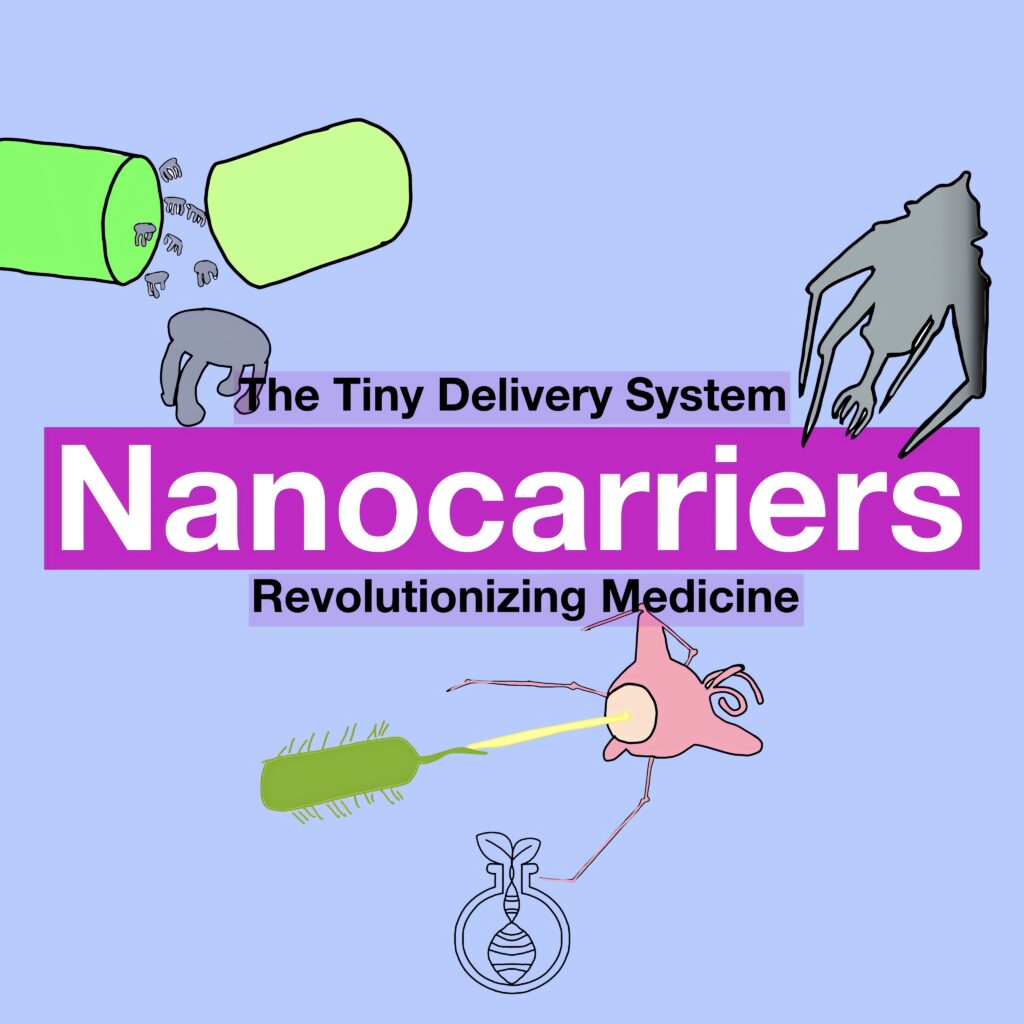Imagine that you are a small packet containing a life-saving medicine floating in the bloodstream. Where is the destination? A cancerous tumor, a bacterial infection, or perhaps a malfunctioning cell deep in the body. But this is not an ordinary journey, because nothing is simple in our bodies. There are obstacles everywhere. These; protective barriers, immune system defenses, and a complex maze of tissues. Without the right guidance, you may never reach your goal. That’s where nanocarriers come in – the ultimate delivery service for the surest task in modern medicine.

What Are Nanocarriers?
Let’s break it down: a nanocarrier is like a microscopic envelope designed to carry therapeutic agents (such as drugs, DNA, or proteins) directly to specific cells or tissues. These tiny couriers, sometimes just a few billionths of a meter wide, are engineered to protect the cargo they carry, guide it to the right address, and ensure it is delivered safely and efficiently. But they don’t just knock on any door—they’re programmed to recognize the exact cells where they need to drop off their load.
In simpler terms: imagine needing to send a very important package to someone, but that person lives in a walled city, surrounded by guards who check everything that comes in.
You wouldn’t want your package to get intercepted, opened, or delivered to the wrong address, right? Nanocarriers work like a special messenger with a secret key, who can get past all the security and deliver the medicine exactly where it’s needed.
Why are Nanocarriers so Important
Our current methods of delivering medicine often come with challenges. When you take a pill or get an injection, the drug travels throughout your whole body, affecting not only the problem area but also healthy tissues. This is why chemotherapy, for example, can cause side effects like hair loss and nausea—it’s a powerful treatment but lacks precision.
Nanocarriers solve this issue by targeting the exact cells that need treatment, leaving healthy cells untouched. They can also carry drugs that otherwise wouldn’t survive the journey through our bodies—whether it’s because they break down too quickly, get filtered out, or can’t penetrate certain barriers. Think of it as equipping the drug with a disguise or armor, allowing it to pass undetected through checkpoints like the liver, immune system, or blood-brain barrier.

Types of Nanocarriers
The beauty of nanocarriers lies in their versatility. Just like there are different types of packaging for different items—envelopes for letters, boxes for fragile goods—there are various kinds of nanocarriers suited to different medical needs. Here are a few:
- Liposomes: These are tiny bubbles made of fat molecules, similar to cell membranes, making them ideal for slipping into cells. Liposomes are already being used to deliver chemotherapy drugs with fewer side effects.
- Polymeric nanoparticles: These are solid, stable particles made of polymers (long chains of molecules). They can be tailored to release their cargo slowly over time, providing long-lasting treatments.
- Dendrimers: Picture a tree with many branches. Dendrimers are tree-like structures with a core, branches, and outer groups that can be customized to attach to different drugs, making them highly specialized couriers.
- Gold nanoparticles: Not only do they look cool under a microscope, but these particles can also be heated using light to kill cancer cells in combination with carrying drugs.
- Carbon nanotubes: These are like rolled-up sheets of carbon atoms that can carry drugs or genes into cells and even help deliver them through the dense blood-brain barrier.
The Future of Nanocarriers
The real magic of nanocarriers is not just what they can do today, but what they can do tomorrow. Picture this: We could design a nanocarrier that finds its way to a tumor, delivers its deadly payload, and then self-destructs without a trace. Or imagine having a nanocarrier patrolling your bloodstream, searching for and neutralizing viruses before you even know you’re sick. In the future, they may be able to offer combinations of drugs such as cancer treatments, antibiotics, gene therapies at the same time, and work like a microscopic medical team in your body.
Researchers are also investigating how nanocarriers can help overcome one of the biggest threats to modern medicine: antibiotic resistance
Challenges and Ethical Considerations
Of course, like any scientific breakthrough, there are challenges to overcome. Creating safe, effective and affordable nanocarriers is a complex puzzle. Scientists are still figuring out how to ensure that the nanocarriers themselves do not trigger immune responses or cause unwanted harm. And as with all medical advances, important ethics questions that need to be addressed. How do we regulate these technologies? Who will have access to these state-of-the-art treatments? And how do we ensure that they are used safely and responsibly?

Conclusion: The Promise of Precision
Nanocarriers represent the future of therapies that are not only powerful, but also precision medicine. They take the guesswork out of medical treatments, minimize side effects, and maximize effectiveness. As we continue to develop and refine these microscopic messengers, we are one step closer to a world where medicine can be personalized to the individual, delivering exactly what is needed, where and when it is needed. In a sense, nanocarriers are rewriting the rules of medicine and moving us from the era of “hit or miss” treatments to a future where every drug is precise, efficient, and smart. So the next time you think of a small package, remember: the inside of that little box could be the key to curing diseases in ways we’re only beginning to imagine.


My name is Ceyda Çelik, I am a passionate molecular biology and genetics student at Başkent University and also content writer for Biologyto. With a deep interest in the natural world and scientific exploration, I aim to share engaging, informative content that makes biology accessible and exciting for everyone. I’m dedicated to helping readers discover the wonders of life through science.





